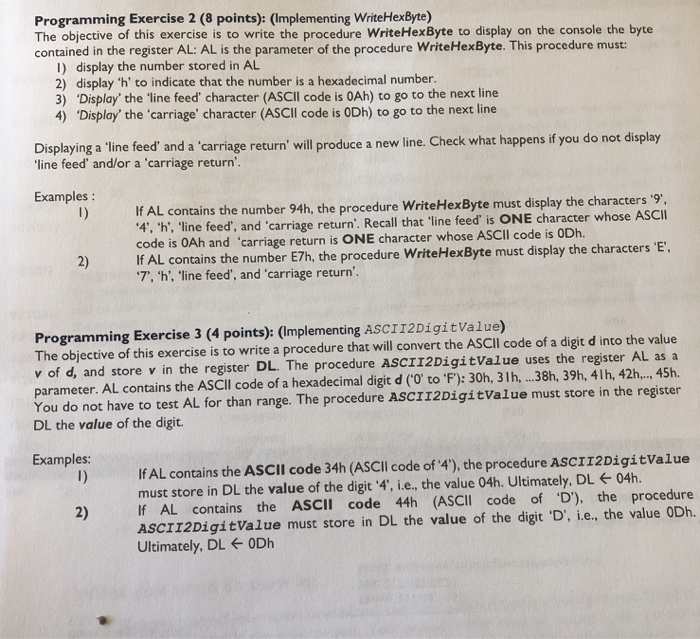Using assembly language

Programming Exercise 2 (8 points): (Implementing WriteHexByte) The objective of this exercise is to write the procedure WriteHexByte to display on the console the byte contained in the register AL: AL is the parameter of the procedure WriteHexByte. This procedure must l) display the number stored in AL 2) display 'h' to indicate that the number is a hexadecimal number 3) Display' the 'line feed' character (ASCII code is 0Ah) to go to the next line 4) Display' the 'carriage' character (ASClI code is 0Dh) to go to the next line Displaying a line feed' and a carriage return' will produce a new line. Check what happens if you do not display line feed' and/or a 'carriage return'. Examples: If AL contains the number 94h, the procedure WriteHexByte must display the characters "9 4', 'h', line feed, and 'carriage return'. Recall that 'line feed is ONE character whose ASCI code is OAh and 'carriage return is ONE character whose ASCll code is 0Dh. If AL contains the number E7h, the procedure WriteHexByte must display the characters ' 7, 'h', 'line feed', and 'carriage return' 2) Programming Exercise 3 (4 points): (Implementing ASCII2Digitvalue) The objective of this exercise is to write a procedure that will convert the ASCll code of a digit d into the value v of d, and store v in the register DL. The procedure ASCII2DigitValue uses the register AL as a parameter. AL contains the ASCIl code of a hexadecimal digit d (O' to 'F): 30h, 31h,.38h, 39h, 4lh, 42h....45h. You do not have to test AL for than range. The procedure AScIT2DigitValue must store in the register DL the value of the digit. Examples: If AL contains the ASClIl code 34h (ASCII code of '4'), the procedure ASCII2Digitvalue must store in DL the value of the digit 4, i.e., the value 04h. Ultimately, DL 04h. If AL contains the AsSCII code 44h (ASCI code of 'D'), the procedure ASC112Digitvalue must store in DL the value of the digit D, i.e., the value 0Dh. Ultimately, DL 0Dh 2) Programming Exercise 2 (8 points): (Implementing WriteHexByte) The objective of this exercise is to write the procedure WriteHexByte to display on the console the byte contained in the register AL: AL is the parameter of the procedure WriteHexByte. This procedure must l) display the number stored in AL 2) display 'h' to indicate that the number is a hexadecimal number 3) Display' the 'line feed' character (ASCII code is 0Ah) to go to the next line 4) Display' the 'carriage' character (ASClI code is 0Dh) to go to the next line Displaying a line feed' and a carriage return' will produce a new line. Check what happens if you do not display line feed' and/or a 'carriage return'. Examples: If AL contains the number 94h, the procedure WriteHexByte must display the characters "9 4', 'h', line feed, and 'carriage return'. Recall that 'line feed is ONE character whose ASCI code is OAh and 'carriage return is ONE character whose ASCll code is 0Dh. If AL contains the number E7h, the procedure WriteHexByte must display the characters ' 7, 'h', 'line feed', and 'carriage return' 2) Programming Exercise 3 (4 points): (Implementing ASCII2Digitvalue) The objective of this exercise is to write a procedure that will convert the ASCll code of a digit d into the value v of d, and store v in the register DL. The procedure ASCII2DigitValue uses the register AL as a parameter. AL contains the ASCIl code of a hexadecimal digit d (O' to 'F): 30h, 31h,.38h, 39h, 4lh, 42h....45h. You do not have to test AL for than range. The procedure AScIT2DigitValue must store in the register DL the value of the digit. Examples: If AL contains the ASClIl code 34h (ASCII code of '4'), the procedure ASCII2Digitvalue must store in DL the value of the digit 4, i.e., the value 04h. Ultimately, DL 04h. If AL contains the AsSCII code 44h (ASCI code of 'D'), the procedure ASC112Digitvalue must store in DL the value of the digit D, i.e., the value 0Dh. Ultimately, DL 0Dh 2)








